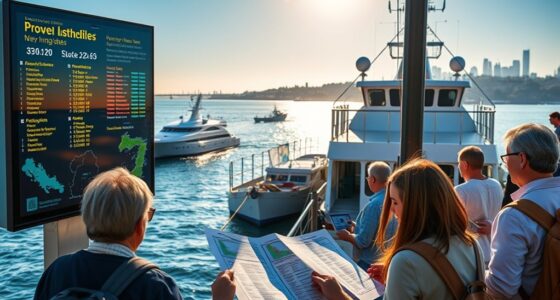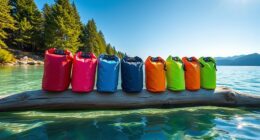To set up a travel first-aid kit, assess your destination, activities, and health needs, then gather essential supplies like bandages, antiseptics, medications, and allergy treatments. Choose a durable, compact container that’s waterproof and easy to carry. Organize items with labels or compartments for quick access and regularly update the contents, replacing expired or used supplies. Staying informed on new safety features can boost your kit’s effectiveness—if you want to learn more, keep exploring these helpful tips.
Key Takeaways
- Assess your destination, activities, and health needs to customize the kit’s contents effectively.
- Choose a durable, waterproof container with organized compartments for easy access and hygiene.
- Include essential supplies like bandages, antiseptics, medications, and natural remedies tailored to your travel.
- Regularly review and update supplies, replacing expired items and adding new safety innovations.
- Label items clearly, keep emergency contacts handy, and familiarize yourself with proper first-aid procedures.
Assessing Your Travel Needs

Before assembling your travel first-aid kit, it’s essential to assess your specific needs based on your destination, activities, and health considerations. Consider any medication management requirements, such as prescription drugs, dosage schedules, or special needs like allergy medications. Check your travel insurance to understand coverage for medical emergencies and verify you’re prepared for potential healthcare costs abroad. Think about the climate and environment—will you need sunscreen or insect repellent? If you have chronic conditions, plan for extra supplies and any necessary documentation. Evaluating these factors helps you determine what medications, prescriptions, or health items to include, ensuring you’re prepared for common issues or emergencies that could arise during your trip. Additionally, understanding local regulations and the availability of medical supplies can help you avoid unexpected complications while traveling. Being aware of local healthcare resources can also be beneficial in case of urgent medical needs, especially as advancements in AI in education and other fields continue to influence healthcare and logistics. Furthermore, staying informed about medical supply regulations can prevent delays or issues when bringing essential items across borders, enhancing your overall preparedness. Moreover, considering the availability of specialized medical supplies in your destination can further enhance your preparedness.
Essential First-Aid Supplies to Include

When assembling your travel first-aid kit, including a well-rounded selection of essential supplies is crucial for handling minor injuries and health issues on the go. Start with basic items like adhesive bandages, antiseptic wipes, gauze pads, and medical tape. Include pain relievers such as acetaminophen or ibuprofen, and any necessary medication management tools like pill organizers. For allergy considerations, pack antihistamines, allergy ointments, and an epinephrine auto-injector if prescribed. Don’t forget scissors, tweezers, and gloves for safe treatment. Consider also including a digital thermometer and cold packs. Having these supplies ensures you’re prepared for common travel mishaps and can effectively manage allergies or medication needs during your trip. Properly stocked supplies help you stay safe and respond promptly to minor health issues. Additionally, understanding the role of contrast ratio in medical imaging can be useful for interpreting certain diagnostic results if needed. It’s also helpful to familiarize yourself with first-aid guidelines to ensure proper response in emergency situations. Knowing how to use basic medical equipment can further improve your preparedness in unexpected situations. Being aware of retirement planning strategies can also be beneficial for long-term financial security, especially when considering potential medical expenses.
Choosing a Durable and Compact Container

Selecting the right container for your travel first-aid kit is key to ensuring your supplies stay organized and protected during your trip. Look for a waterproof casing to keep contents safe from water, humidity, or spills. A durable container made from impact-resistant materials will withstand rough handling and accidental drops. Opt for a lightweight design so it doesn’t add unnecessary bulk to your luggage or backpack. Compactness is essential to fit easily into your travel gear without sacrificing space for other essentials. Consider a container with secure closures to prevent accidental openings, especially during transit. Impact-resistant materials help ensure your kit remains intact despite rough handling. Additionally, choosing a container with waterproof features will protect your supplies from unexpected weather conditions. Using a container with easy-to-clean surfaces can also be beneficial for maintaining hygiene and quick sanitizing. Selecting a container with proper organization compartments can help keep your supplies neatly separated and easily accessible. By choosing a sturdy, waterproof, and lightweight container, you’ll keep your first-aid supplies safe, accessible, and ready for any minor emergencies while on the go.
Organizing Your Kit for Quick Access

How can you guarantee that your first-aid supplies are easy to find in an emergency? Proper organization is key. Use clear labeling techniques to identify each item quickly, especially for medications. Store essentials like pain relievers, antihistamines, and ointments separately, so you can grab what you need without delay. Consider compartmentalizing your kit with small containers or bags to keep items sorted. Use a simple chart to help you remember where everything is. Here’s an example:
| Item Type | Location |
|---|---|
| Pain medication | Front pocket |
| Bandages & ointments | Middle compartment |
| Medication organization | Labeled sections |
This setup minimizes search time and ensures you’re prepared for any situation. Additionally, implementing predictive analytics can help monitor your supplies and alert you when stocks are running low, keeping your kit ready at all times. Incorporating modern organization techniques can further streamline access during emergencies. Regularly reviewing your kit and updating it based on first-aid guidelines ensures that your supplies remain current and effective. Maintaining a comprehensive inventory can help you quickly identify missing or expired items. Moreover, adopting vibrational alignment practices can help maintain your overall well-being and preparedness in stressful situations.
Maintaining and Updating Your First-Aid Kit

Regularly checking and updating your first-aid kit is essential to guarantee it remains effective and ready for use. You should periodically review all supplies, replacing expired medications and used items. Proper medication management ensures you have necessary medicines, such as pain relievers or antihistamines, in working condition. Keep emergency contact info up to date and easily accessible within the kit, so you can quickly reach out for help if needed. Also, verify that instructions for use are clear and intact. Discard any expired or damaged supplies, and restock items that are running low. Staying diligent with maintenance minimizes risks and guarantees you’re prepared for any travel emergency. Additionally, understanding industry trends can help you stay informed about new and improved first-aid supplies to include. Being aware of technological advancements in first-aid products can further enhance your preparedness. Regularly exploring innovations in first-aid technology ensures your kit benefits from the latest safety features. Incorporating essential oils into your health routine can also support overall well-being during travels. For example, some natural remedies can provide additional comfort and aid in recovery when used appropriately.
Frequently Asked Questions
How Should I Customize My First-Aid Kit for Specific Destinations?
When customizing your first-aid kit for specific destinations, consider the local health risks and pack destination-specific supplies. For tropical locations, include insect repellent, anti-malarial medication, and sunscreen. In colder regions, add hand warmers and blister treatment. Research common ailments in your destination and carry appropriate medications, antiseptics, or bandages. Tailoring your kit guarantees you’re prepared for health issues unique to your travel spot, keeping you safer and more comfortable.
What Are the Legal Considerations for Carrying Medical Supplies Abroad?
When carrying medical supplies abroad, you need to ensure legal restrictions and import regulations. You should check the specific country’s rules on bringing in medications and medical devices, as some items may be prohibited or require special permits. Failing to comply can lead to confiscation or legal issues. Always research ahead, carry proper documentation, and avoid bringing banned substances to ensure smooth travel with your first-aid kit.
How Often Should I Perform a Complete Review of My Kit?
You might think a quick glance now and then suffices, but that’s like ignoring emergency preparedness until you actually need it. For your travel first-aid kit, you should perform a complete review at least every six months or before any trip. Routine maintenance guarantees supplies stay effective and ready. Regular checks help prevent surprises, so you’re always prepared for minor mishaps or unexpected emergencies on your adventures.
Can I Include Prescription Medications in My Travel First-Aid Kit?
Yes, you can include prescription medications in your travel safety kit, but make certain they’re stored properly and clearly labeled. Carry enough medication for the entire trip, plus some extra in case of delays. Always bring a copy of your prescriptions and inform your travel companions. Including essential medications ensures you’re prepared for medical needs, helping you stay safe and healthy during your travels.
What Are the Best Practices for Training Family Members in Using the Kit?
You should prioritize effective family training for emergency scenarios by demonstrating how to use your first-aid kit properly. Practice applying bandages, using antiseptics, and managing common injuries. Encourage family members to ask questions and repeat the steps until they’re confident. Regular drills help reinforce skills and guarantee everyone is aware of their role during an emergency. Keep training simple, clear, and engaging to build confidence and preparedness for any situation.
Conclusion
So, now you’re basically a travel first-aid ninja, ready to tackle minor mishaps with your shiny new kit. Just remember, a well-organized, compact container isn’t just for looks—it’s your secret weapon against chaos. Keep it updated, and avoid turning it into a forgotten treasure chest on your shelf. Because nothing says “prepared traveler” like knowing you’ve got everything from Band-Aids to bug spray—except maybe a magic wand. Stay safe, adventure awaits!









